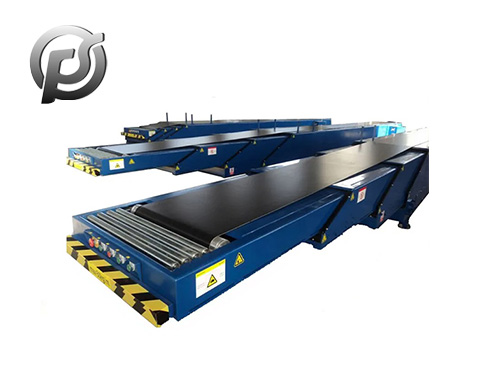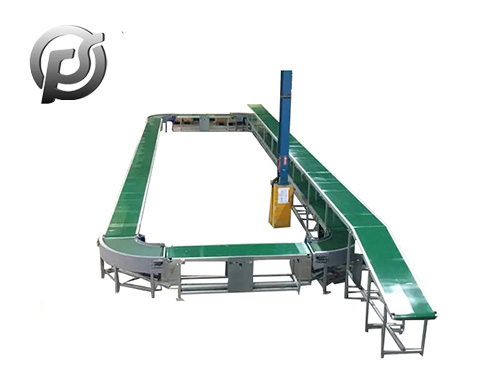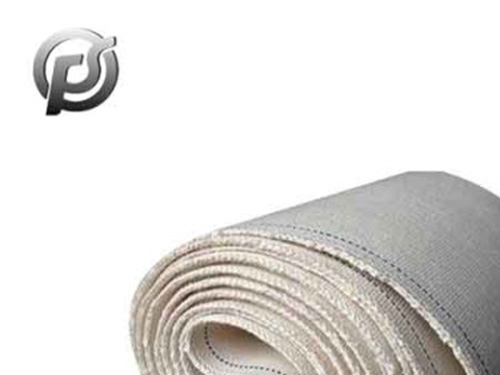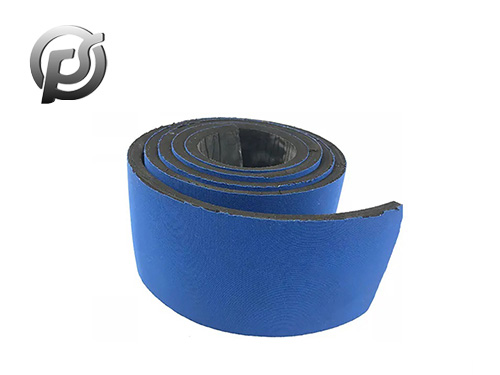There are three key points for installation of large dip Angle
belt conveyor: installation sequence of equipment (improper installation sequence will cause rework); The center line of the upper and lower bend must coincide with the center line of the whole machine (ignoring this point will cause serious deviation of the belt is difficult to adjust); Wavy guard belt laying and fixing (because this kind of belt is ring, and has guard edge and diaphragm, unlike ordinary belt roll easy transportation, general folding grow square arrival, causing difficulties to laying).
1, large dip Angle belt conveyor construction difficulties analysis
Wavy large dip Angle belt conveyor laying is one of the key processes of the whole installation project, ordinary belt laying usually adopts the whole roll belt to the head, the belt center inserted a round tube, and then lifted with inverted chain, with the belt rolling from high to low laying, saving time and effort; It folds and grows square, the shape is long and high, and does not have the characteristics of the whole roll belt rolling. In addition, there are guards and partitions on the appearance of the wavy-shaped belt with large Angle, which is not conducive to sliding, so it is more difficult to lay the belt with large Angle. Therefore, choosing a reasonable and advanced installation sequence is an important guarantee to ensure safety, reduce costs, improve belt laying quality and work efficiency, and shorten the construction period.
2, large dip Angle belt conveyor construction sequence optimization
For a long time, the installation of large dip Angle belt conveyor with the traditional belt machine installation sequence, first install the head, tail, after the installation of the fuselage, such as the upper and lower roller frame and roller installation after the belt laying. Based on the analysis of the equipment structure and the actual situation on site, we decided to align the nose first, and not install the fuselage and tail for the time being. Then the belt is laid, and the nose roller is installed and fixed through the belt. Finally, the installation sequence of the fuselage and tail is carried out. When fixing the belt, follow the sequence of first two ends (head, tail roller) and then middle (concave arc press belt wheel and upper flat roller, etc.).
3, large dip Angle belt conveyor construction steps
3.1 Check the quantity and quality of equipment according to the drawings.
3.2 Find out the crosshair of the center line of the whole machine and the center line of the head and tail wheels according to the drawing.
Inspection of the appearance of the foundation: the main inspection of the foundation surface has honeycomb, hemp surface, cracks, bare bars and other quality defects, especially the layout of the position of the foundation surface should not be exposed steel bars, more can not be plastered with mortar, with 5kg hammer knock foundation, check the density, there should be no hollow sound.
3.3 Installing the head Frame. Fix the head frame with the center line of the machine and the cross line of the head wheel (welded and fixed firmly)
3.4 Laying ring guard tape.
3.5 Based on the center line of the head and tail frame, install the support leg of the middle frame, the middle frame and the tail frame in turn from the head (the tail frame shall not be fixed firmly, and can be spot-welded). The installation of the upper and lower bend sections must ensure that the center line of the upper and lower sections coincide with the center line of the whole machine, otherwise it will cause the conveyor belt of the wavy guard side to run off.
3.6 Install return idlers and convex arc pressure belt wheel. Do not install other idlers and rollers temporarily. Then loosen the chain and drop the belt onto the shelf.
3.7 Install the upper flat roller and tighten the roller (over the ring conveyor belt and install it on the frame). When installing the tensioning roller, the tensioning device should be adjusted to the loosest position so as to install the concave arc roller, concave arc roller and convex arc roller.
3.8 Install the concave arc press wheel, concave arc supporting roller, convex arc supporting roller and upper baffle roller. Adjust the tensioning device after the installation of the supporting roller and the retaining roller, and initially tighten the conveyor belt. If the belt can be tensioned within the adjustment range of the tensioning device, the tail can be fixed and welded. When the tensioning device is adjusted to the tightest place and the belt is still loose, the tail should be moved back and fixed again.
 Custom Conveyor Belts: Enhancing Efficiency and Productivity
Custom Conveyor Belts: Enhancing Efficiency and Productivity
 Stone Belt Conveyor: Efficient Material Handling Solution for Mining and Construction
Stone Belt Conveyor: Efficient Material Handling Solution for Mining and Construction
 Exploring the Dynamics of Conveyor Belt Manufacturing in China
Exploring the Dynamics of Conveyor Belt Manufacturing in China
 PE Conveyor Belts: Characteristics, Applications, and Advantages
PE Conveyor Belts: Characteristics, Applications, and Advantages